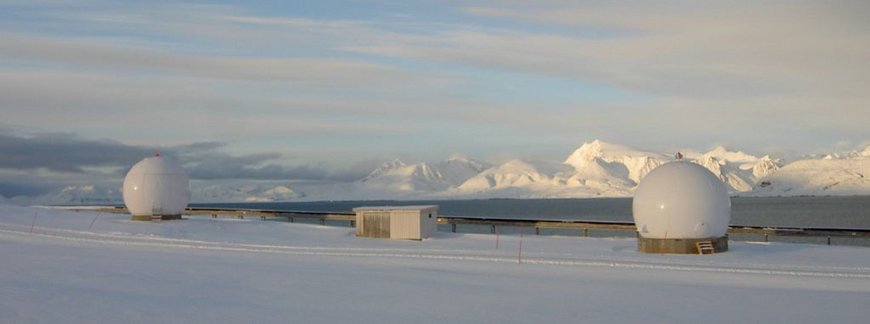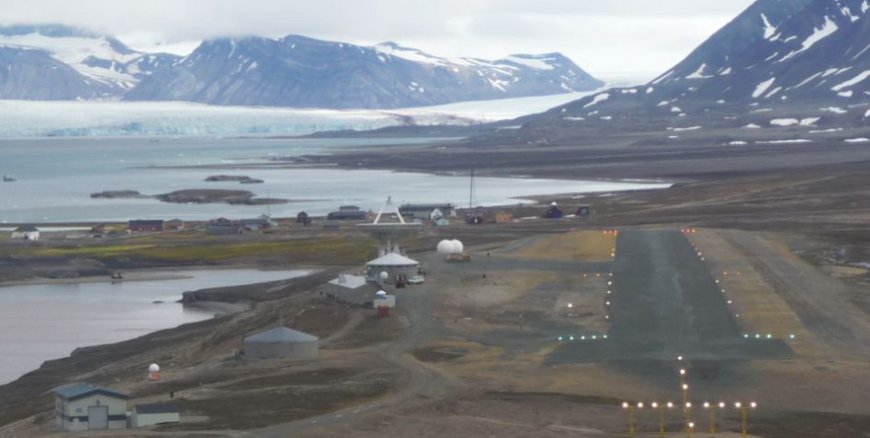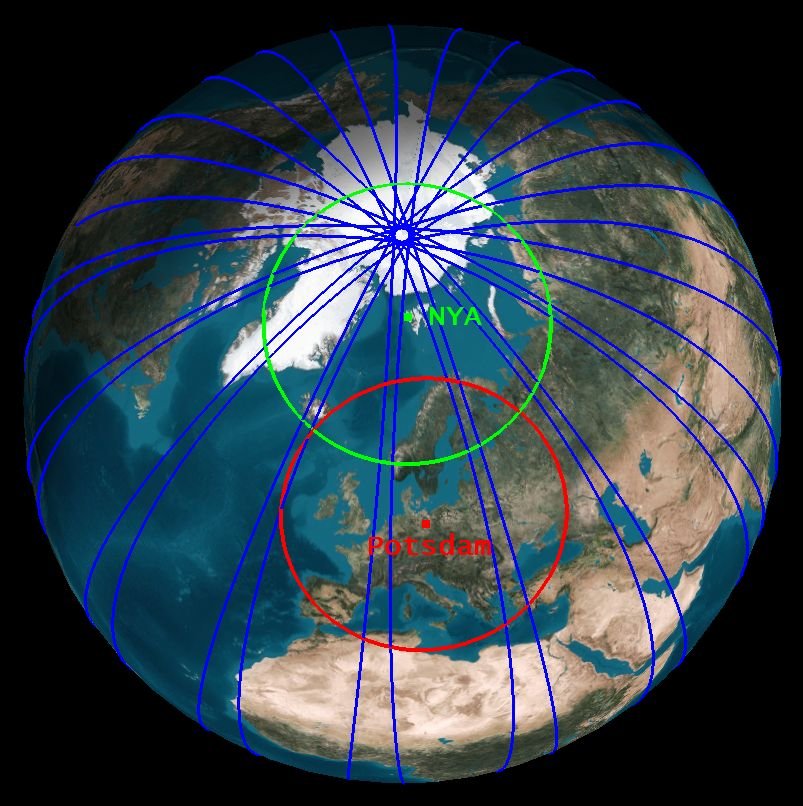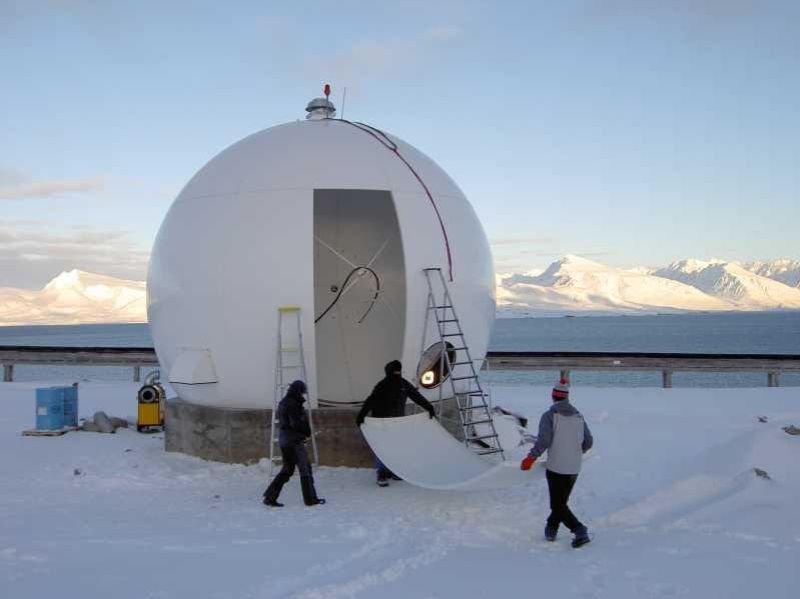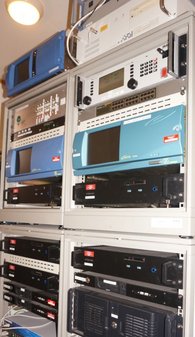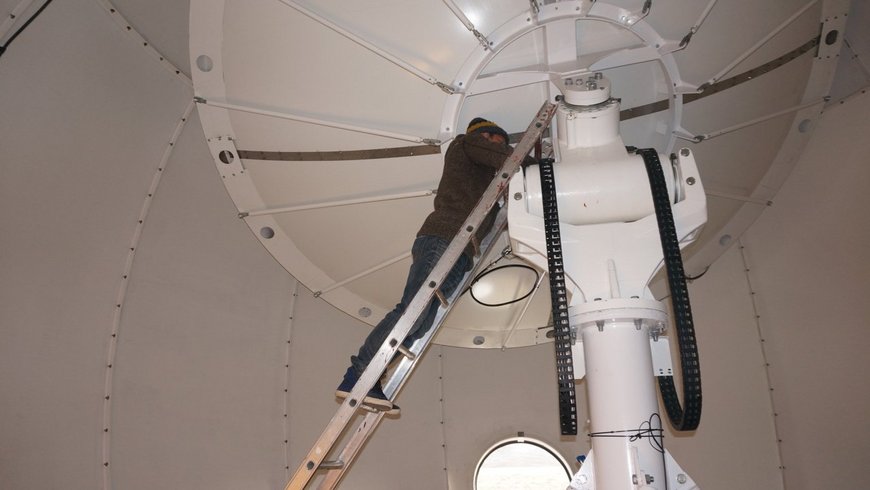Satellite Receiving Station Ny-Ålesund
The GFZ German Research Centre for Geosciences operates a satellite receiving station at Ny-Ålesund, Spitsbergen (78° 55´ North, 11° 56´ East) to receive data from research satellites in polar orbits. The station is located about 1 km outside the village, between the local airport and the Kings Bay (Kongsfjord). Ny-Ålesund is the northernmost location (ca. 1200 km to the North Pole) with regular travel connections (aircraft, ship). Between 30 and 180 inhabitants (permanent staff and visiting scientists) get supplies from the Kings Bay Company, which operates also the local infrastructure (harbor, road system, energy, etc.).
Reference
Falck, C., Reißland, S., Snopek, K., Massmann, F.-H. (2020): Satellite data reception at Ny-Ålesund, Spitsbergen: From CHAMP to GRACE Follow-On. - ZfV: Zeitschrift für Geodäsie, Geoinformation und Landmanagement, 145, 2, 111-117. https://geodaesie.info/zfv/heftbeitrag/8568/zfv_2020_2_Falck_et-al.pdf
Many scientific satellites for the observation of the Earth and the near Earth space are in polar orbits with low altitudes and short orbital periods (e.g., 95 minutes). The low altitude orbits are favorable for many types of observations because the satellites are relatively close to the environment to be observed. The polar orbits allow observations over all areas of the Earth, including the polar zones.
Satellites must be in the field of view of ground stations to send their observation data to Earth. The graphic below shows the areas of visibility of Potsdam (red circle) and the ground station at Ny-Ålesund (NYA, green circle). The ground tracks of the both GRACE Follow On satellite orbits over 24 hours (blue lines) cross the circle of visibility of Potsdam only about 4 times per day (due to the revolution of the Earth). The mean age of data from the GRACE Follow On (and other polar orbiting) satellites can thus not be less than about 6 hours, if they were received at Potsdam. The NYA station can make in average at least 15 contacts with each of these satellites in the same time (24 hours), independently from the Earth’s rotation, which results in a maximum data age of about 1.5 hours only.
The ability to provide data from satellites in polar orbits such fast is the great advantage of a polar ground station. In praxis this ability is even a mandatory precondition for the utilization of such satellite data in time critical applications.
The frequent and regular satellite data reception at the NYA station is an important precondition for many applications with tight time constraints. An example is the satellite-based GNSS Atmosphere Sounding, an innovative method to determine temperature and water vapor profiles, which supports, among other things, the improvement of weather forecasts. The onboard satellite measurements are performed with special GNSS-receivers, such as the GFZ-operated TOR Payloads on TerraSAR-X and TanDEM-X. The data products, which are delivered to weather forecast centers, must not be older than 3 hours, which is achieved particularly through the prompt satellite reception at Ny-Ålesund.
Another example is the operational provision of precise satellite orbit predictions for the ILRS (International Laser Ranging Service), on basis of GNSS data as recorded onboard the satellites. This allows the globally distributed laser ranging stations (e.g., SLR-station Potsdam) a more accurate orientation of their Laser instruments to the satellites, which supports a high Laser-tracking coverage of the satellite orbits.
The frequent contacts to the satellites allow, beside the scientific benefit, also a quasi-continuous technical monitoring of the satellites. Technical problems on satellites can be detected early and critical situations might be avoided. This can help to reduce outage times and to support a long lifetime of the monitored satellites.
The operation costs of the NYA station are relatively low, which results mainly from the largely automated, unmanned operation. This allows GFZ to support satellite missions which cannot afford expensive contacts with other ground stations. Examples are the satellite Flying Laptop(built by students at the University of Stuttgart), which is received since 2017, and the satellite TUBIN (built by students at Technische Universität Berlin), which is received since 2022.
The actually most important task of the NYA station is the reception of the both GRACE Follow On satellites (in orbit since 2018). GFZ is responsible for the complete reception of the satellite data for what the NYA station is deployed as the mission’s primary receiving station.
The first antenna system of the site is in operation since 2001 and served initially for the reception of the satellite CHAMP only, which gave the impulse for the installation. The station was continuously modernized and extended by GFZ since 2002, among other things with high-performance receivers (2004, 2006, 2007 and 2017). Already in 2005 the hut (operation cabin) was extended for new equipment and a second antenna system was installed. Since then two satellites can be received at the same time or one satellite by two antennas simultaneously (redundant). Previous to the actually received satellites GRACE-FO-A, GRACE-FO-B, TerraSAR-X, TanDEM-X, Flying Laptop and TUBIN the station received the satellites CHAMP, BIRD, GRACE-A, GRACE-B and SAC-C.
The GFZ is member of NySMAC (Ny-Ålesund Science Managers Committee), which aims for the development of research activities in Ny-Ålesund and the local environment protection.
The both antenna systems of the station (parabolic reflectors with a diameter of 4 m) are sheltered against the rough climate conditions on Spitsbergen by heatable radomes. They allow satellite reception in the S-band (about 2.2 – 2.45 GHz) and in the X-band (about 7.9 – 8.4 GHz). The receiver and steering devices are placed in a small hut between the radomes. Almost all devices exist at least twice and are operated in parallel. Thus the failure of one device does not necessarily cause an interruption of reception.
All satellite contacts of the station are scheduled by GFZ (section 1.2, “Development, Operation and Analysis of Gravity Field Satellite Missions”), in cooperation with the agencies which are responsible for the satellites and project partners. Data received at the station is automatically sent to GFZ, where it is processed and distributed to other users. The station is operated unmanned all-the-year, but continuously monitored and remotely controlled by GFZ with special technical devices and cameras. The German-French AWIPEV research station at Ny-Ålesund as well as the Kings Bay Company give support in case of problems which cannot be solved from remote. Extension-, maintenance- and repair-works at the station are executed by GFZ, usually once per year.


